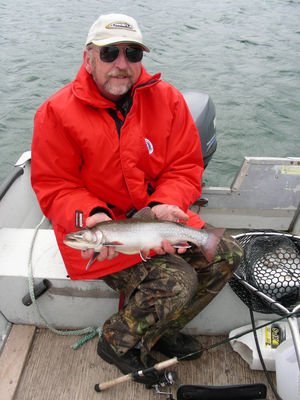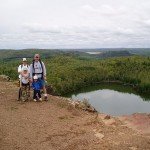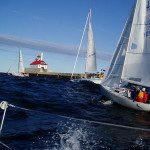“We are leaving for another world,” remarked Captain Gary Lange as we slid away from the marina dock and headed down the mighty Nipigon River for Lake Superior.
Four of us were aboard the 47-foot trawler, Anica Lee—Lange, his friends Karlo Kaustinen and Chesley Imhoff, and myself. Lange described Karlo as “the only person other than my daughters who can operate my boats.” Imhoff, known as “Ches,” has roamed the island-studded waters of Lake Superior’s Canadian North Shore since the 1950s. This is well before the era of cheap flights and the influx of visitors during the summer months. He knows these waters like the back of his hand. He knows each island that dots the scenery.
We were headed for Lange’s camp on Bowman Island, 24 miles away. With the Anica Lee traveling at seven knots, it took us four hours to get there–going down the Nipigon River, 12 miles across Superior’s Nipigon Bay, then through the Nipigon Straits and tricky Blind Channel to the outer side of massive St. Ignace Island, where Bowman Island lies amidst a cluster of small islands and shallow shoals.
Lange started coming out here 48 years ago as a young teenager with a 14-foot boat and an 18-horse outboard. Twenty-five years ago he purchased land on Bowman Island, constructed a small concrete dock on a sheltered beach and began building a camp. Today, at one of the most remote places on Lake Superior, he has a spacious, solar-powered lodge that is his home-away-from-home from ice-out until freeze-up. Lange’s Bowman Island Charters (www.BowmanIslandCharters.com) is one of just two commercial operations on the waters off St. Ignace Island and the Black Bay Peninsula.
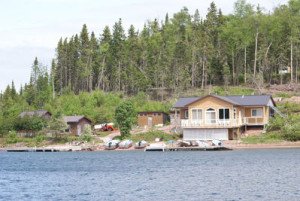
This is the best place on Lake Superior to fish for what Canadians simply call “specks,” also known as coaster brook trout. These out-sized char, now rare elsewhere in the lake, are world famous. From the 1800s through the 1950s, avid anglers, including dignitaries like the Prince of Wales, made pilgrimages to Nipigon to catch brook trout. The world record brook trout, weighing 14.5 pounds, was landed in the Nipigon River in 1915.
For a host of reasons, brook trout numbers dwindled in the 1960s. A recovery effort begun in the 1990s is now paying dividends. Lange says the fishing for coasters is better than it has ever been in his lifetime. With a bag limit of one brook trout at least 22 inches long, this is essentially a catch-and-release fishery.
Keepers exist—anglers at Lange’s camp caught (and released) more than a half-dozen of them in May and June—but the average specks are 17 to 20 inches long and weigh two to four pounds.
During my stay, we caught coaster brook trout and steelhead by casting small spoons, spinners, and flies near the mouths of rain-swollen creeks along the St. Ignace shoreline. The water coming out of the creeks was a few degrees warmer than the frigid lake, thus attracting hungry trout. Karlo and Ches successfully trolled for lake trout along shallow shoals.
Kayaks, Comfort, and History
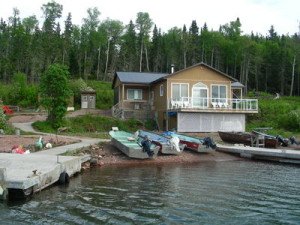
Lange is expanding his business to include kayakers and folks who want to experience the wild islands while enjoying his comfortable camp. In addition to the Anica Lee, Lange operates a faster 30-foot water taxi. Kayakers can arrange for drop-offs and pick-ups at various locations. They can also stay at the lodge and make paddling day trips. Hiking and beach-walking are available on St. Ignace Island.
“The lodge is a great place for older kayakers and adventurers who want to explore this place, but don’t want to rough it,” says Lange. “I am working with Quebec Lodge B&B in Red Rock to provide accommodations before and after a trip to Bowman Island.”
Within a short distance (by water) from the lodge are historical sites. Ancient beach terraces on Bowman Island contain Pukaskwa Pits dug by prehistoric peoples. Near an old commercial fishing camp on the south side of Bowman Island is the grave of Thomas Lamphier, a lighthouse keeper on nearby Talbot Island who died in 1869. Lamphier and his wife were spending the winter at the remote lighthouse when he died suddenly. Unable to bury him on the rocky island, his wife wrapped the frozen body in canvas and stored it in a rocky crevasse. In the spring, she flagged down a passing boat and the occupants helped her bring the body to Bowman Island and bury it. Lamphier was one of three lightkeepers who died while tending the Talbot Island light, leading the Canadian government to close it.
For More Information
You can visit the website at:
www.BowmanIslandCharters.com. If you have questions about visiting Bowman Island, you can call Gary Lange at (807) 886-2504.


